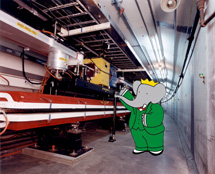

Monday - November 2, 2009
SLAC Today is
available online at:
http://today.slac.stanford.edu
In this issue:
High-Precision Measurements Confirm Cosmologists' Standard View of the Universe
BaBar Collaboration Meeting Kicks Off Today
Concert to Launch Fermi Telescope Meeting in D.C. Today
 |
 |
|
Monday - November 2, 2009 |
High-Precision Measurements Confirm Cosmologists' Standard View of the UniverseThe QUaD collaboration uses the 2.6-meter telescope shown here to view the temperature and polarization of the cosmic microwave background, a faintly glowing relic of the hot, dense, young universe. (Image courtesy of Nicolle Rager Fuller, NSF.)
A detailed picture of the seeds of structures in the universe has been unveiled by an international team co-led by Sarah Church of the Kavli Institute for Particle Astrophysics and Cosmology, jointly located at the Department of Energy's SLAC National Accelerator Laboratory and Stanford University, and by Walter Gear, of Cardiff University in the United Kingdom. These measurements of the cosmic microwave background—a faintly glowing relic of the hot, dense, young universe—put limits on proposed alternatives to the standard model of cosmology and provide further support for the standard cosmological model, confirming that dark matter and dark energy make up 95 percent of everything in existence, while ordinary matter makes up just 5 percent. "When I first started in this field, some people were adamant that they understood the contents of the universe quite well," said Church, deputy director of KIPAC and the U.S. principal investigator of the QUaD project. "But that understanding was shattered when evidence for dark energy was discovered. Now that we again feel we have a very good understanding of what makes up the universe, it's extremely important for us to amass strong evidence using many different measurement techniques that this model is correct, so that this doesn't happen again." In a paper published in the November 1 issue of The Astrophysical Journal, QUaD researchers release detailed maps of the cosmic microwave background. Read more... BaBar Collaboration Meeting Kicks Off Today An industrious meeting for the BaBar collaboration convenes today at SLAC, focusing on the project's ongoing analyses, future publications and conference presentations. Plenary sessions are being held in Panofsky Auditorium to broadcast news to all members, while parallel meetings on specific topics will take place throughout the week. Deciding when to disclose recent findings to the scientific community will be a high priority during this weeks' meeting. "This is an exciting time as we take stock of the hard work of the many people analyzing BaBar's tremendously rich data set," said Mike Roney, BaBar Physics Analysis Coordinator, "and determine which analyses we will be ready to present at upcoming conferences." BaBar is set to exhibit research at this winter's round of particle physics conferences, including the Aspen Particle Physics Conference and European conferences. But predicting which teams' data will be ready in time can be difficult. For example, one team could hit an unforeseen analysis difficulty a few weeks before a conference and the collaboration will need to be flexible and adjust. This week the BaBar team will also prepare for their future Archival Period, starting in 2013, when data analysis will be carried under a lighter organization . Creating a smooth transition to this era remains a big challenge. "This will be another approach for doing analysis," explained BaBar Computing Coordinator Homer Neal. The data have been fully reprocessed last year, but the computing framework has to be simplified, removing all tricks and dependencies on external software, which can become obsolete. The archive period will give access to a vast and important resource for scientists to mine. Francois Le Diberder, spokesperson of the collaboration emphasized, "For the Archival Period, failure is not an option!" Concert to Launch Fermi Telescope Meeting in D.C. TodayThe music of the spheres will take on a new meaning during the 2009 Fermi International Science Symposium in Washington, D.C. , today through Friday, November 5, looking back on the first year of spectacular results from the Fermi Gamma-ray Space Telescope (previously known as GLAST). A highlight of this science symposium will be a live, public concert, hosted by actress Alfre Woodard, today at the John F. Kennedy Center for the Performing Arts. This concert, produced and sponsored by founder and CEO of Classical Archives in Palo Alto, Pierre Schwob, will feature two works by composer Nolan Gasser: the GLAST Prelude, Opus 12, for brass quintet and the World Premiere of Cosmic Reflection: A Narrated Symphony, Opus 15. During the first half of the concert, the American Brass Quintet will perform the GLAST Prelude, which Classical Archives commissioned in celebration of the Fermi telescope's launch in June 2008. In the second half, the Boston University Symphony Orchestra, conducted by David Hoose, will perform the 40-minute Cosmic Reflection symphony, which Stanford and Classical Archives jointly commissioned in celebration of the Fermi telescope's first year of results. British actor/playwright Carey Harrison will narrate the symphony. In addition, synchronized video images, produced by Rich Melnick at NASA's Goddard Space Flight Center, will accompany the performances of both Gasser's Prelude and Symphony. Read more from the Hansen Experimental Physics Lab at Stanford... |
Events
Access (see all)
Announcements
|
|
| | ||
|
|
||
 <%
Response.AddHeader "Last-modified", getArticleDate()
'Response.AddHeader "Last-modified","Mon, 01 Sep 1997 01:03:33 GMT"
'Monday, December 06, 2010
%>
<%
Response.AddHeader "Last-modified", getArticleDate()
'Response.AddHeader "Last-modified","Mon, 01 Sep 1997 01:03:33 GMT"
'Monday, December 06, 2010
%>View online at http://today.slac.stanford.edu/. |
||